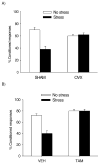Estrogen-mediated effects on depression and memory formation in females
- PMID: 12646301
- PMCID: PMC3374589
- DOI: 10.1016/s0165-0327(02)00428-7
Estrogen-mediated effects on depression and memory formation in females
Abstract
Women are twice as likely to suffer from depression as men. It has been proposed that the ovarian hormones estrogen and progesterone contribute to the higher incidence of this potentially debilitating disorder. Depression can also be accompanied by a loss of cognitive performance. Here we review estrogen-mediated effects on depression and memory formation in females. We propose that changes in levels of estrogen are associated with sex differences in learning as well as changes in affect prior to menses, immediately after pregnancy and during perimenopause and the menopausal transition. Finally, we discuss the animal model of depression known as 'learned helplessness' and describe research from our laboratory demonstrating that exposure to an acute stressful experience compromises a female's later ability to acquire certain types of new memories. This response to stressful experience is opposite to that observed in males and is dependent on the presence of estrogen, and more specifically-changing levels of estrogen. This observation indicates that females and males can use different hormonal and neural mechanisms to respond to the same emotional event and underscore the importance of studying the unique and changing biology of females, especially when considering treatment strategies for depression and stress-related illness.
Figures





Similar articles
-
A reproductive subtype of depression: conceptualizing models and moving toward etiology.Harv Rev Psychiatry. 2009;17(2):72-86. doi: 10.1080/10673220902899706. Harv Rev Psychiatry. 2009. PMID: 19373617 Free PMC article. Review.
-
Estrogen, Stress, and Depression: Cognitive and Biological Interactions.Annu Rev Clin Psychol. 2019 May 7;15:399-423. doi: 10.1146/annurev-clinpsy-050718-095557. Epub 2019 Feb 20. Annu Rev Clin Psychol. 2019. PMID: 30786242 Free PMC article. Review.
-
Hormonal basis of proceptivity and receptivity in female primates.Arch Sex Behav. 1977 May;6(3):173-92. doi: 10.1007/BF01541126. Arch Sex Behav. 1977. PMID: 405957
-
Role of estrogen in sex differences in memory, emotion and neuropsychiatric disorders.Mol Biol Rep. 2024 Mar 12;51(1):415. doi: 10.1007/s11033-024-09374-z. Mol Biol Rep. 2024. PMID: 38472517 Review.
-
Depression in peri- and postmenopausal women: prevalence, pathophysiology and pharmacological management.Drugs Aging. 2013 Sep;30(9):677-85. doi: 10.1007/s40266-013-0100-1. Drugs Aging. 2013. PMID: 23801148 Review.
Cited by
-
Dietary total antioxidant capacity as a preventive factor against depression in climacteric women.Dement Neuropsychol. 2019 Jul-Sep;13(3):305-311. doi: 10.1590/1980-57642018dn13-030007. Dement Neuropsychol. 2019. PMID: 31555403 Free PMC article.
-
Effects of Inflammation and Depression on Telomere Length in Young Adults in the United States.J Clin Med. 2019 May 19;8(5):711. doi: 10.3390/jcm8050711. J Clin Med. 2019. PMID: 31109116 Free PMC article.
-
Predictors of Post-Stroke Depression: A Retrospective Cohort Study.Brain Sci. 2022 Jul 27;12(8):993. doi: 10.3390/brainsci12080993. Brain Sci. 2022. PMID: 35892434 Free PMC article.
-
Males and females respond differently to controllability and antidepressant treatment.Biol Psychiatry. 2004 Dec 15;56(12):964-70. doi: 10.1016/j.biopsych.2004.09.018. Biol Psychiatry. 2004. PMID: 15601607 Free PMC article.
-
Gut microbiota: Linking nutrition and perinatal depression.Front Cell Infect Microbiol. 2022 Aug 26;12:932309. doi: 10.3389/fcimb.2022.932309. eCollection 2022. Front Cell Infect Microbiol. 2022. PMID: 36093196 Free PMC article. Review.
References
-
- Avis NE, McKinlay SM. The Massachusetts Women’s Health Study: an epidemiologic investigation of the menopause. J Am Med Assoc. 1995;50:45–49. - PubMed
-
- Banki CM, Arato M, O’Connor L, Nemeroff CB. Cerebrospinal fluid corticotropin-releasing factor-like immuno-reactivity in depression and schizophrenia. Am J Psychiatry. 1987;144:873–877. - PubMed
-
- Bethea CL. Colocalization of progestin receptors with serotonin in raphe neurons of macaque. Neuroendocrinology. 1993;57:1–6. - PubMed
-
- Bethea CL, Pecins-Thompson M, Schutzer WE, Gundlah C, Lu ZN. Ovarian steroids and serotonin neural function. Mol Neurobiol. 1999;18:87–123. - PubMed
Publication types
MeSH terms
Substances
Grants and funding
LinkOut - more resources
Full Text Sources
Medical

